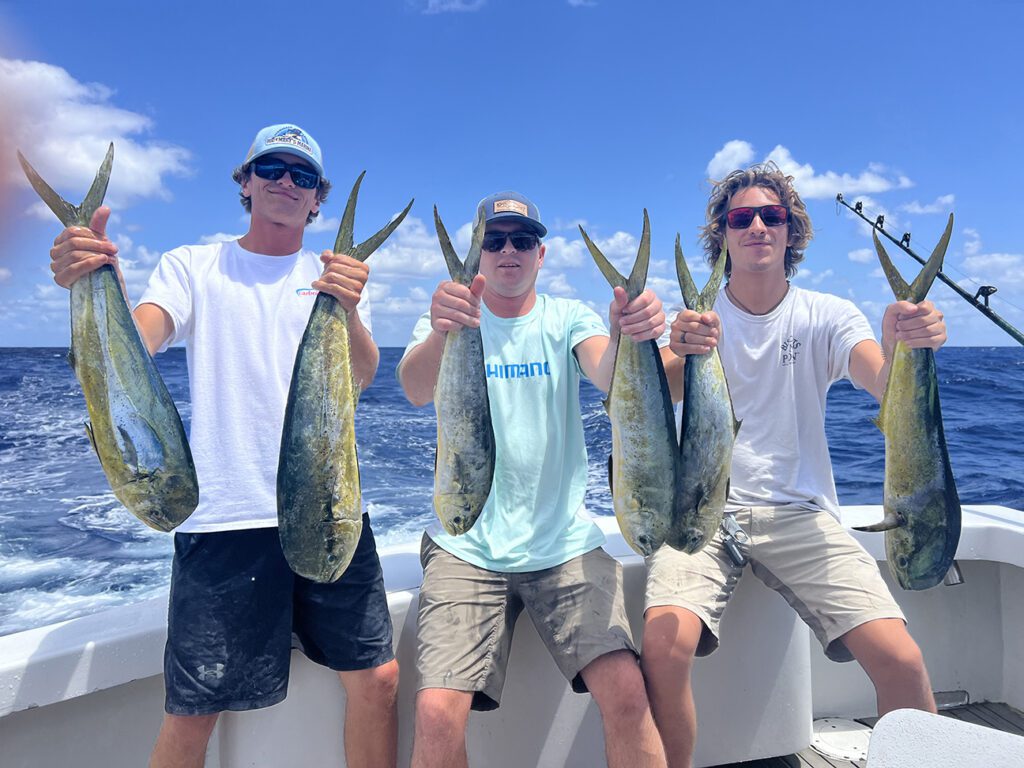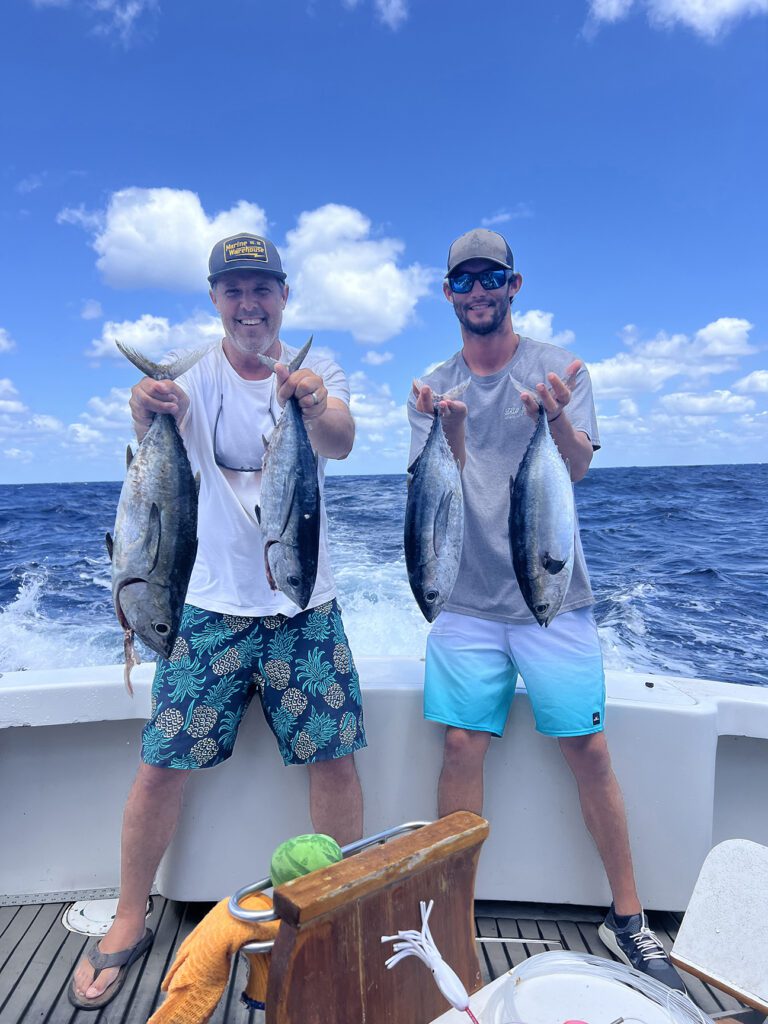Tidelines – July 2024
The forecast, explained Capt. Cody Garner of Reel Time Charters out of Atlantic Beach, had the wind blowing a straight 15 knots out of the east. Typically that blows right against the Gulf Stream, and when current and wind collide, conditions get choppy and rough. Cody thought about stopping a little short of the Gulf Stream at 28-30 miles out and in 100’ of water to target mahi, but he pushed out further to the 40-mile mark and 200’ of water to start our day targeting blackfins.
“Blackfin tuna are a structure-oriented fish. We’re right here on the edge of the Continental Shelf where they’ve made a little home for the summer,” he continued, as Mate Holden Brown quickly put out a spread of cedar plugs and Green Machines with and without birds.
In addition to the six lines out, the spread included two squid chains followed by an Ilander Express with a fake rubber mackerel on the back, and a naked ballyhoo was on the planer rod in hopes for a wahoo.
Holden and Cody had been catching blackfins in this area for about a month now, and while the conditions just as Cody had predicted, bumpy but fishable, on our morning the fish were once again home. We started picking up blackfins almost immediately and steadily.
“Often you can mark a big pile of bait and/or blackfins,” explained Cody, “and once you find them, you can basically circle them.”
Cody was marking both bait and fish on the machine, and just about every rod got bit at some point, including the planer rod. The planer rod wasn’t finding wahoo, though, just blackfins, so Holden paused on the ballyhoo and rigged a Drone spoon, which also produced blackfins.
Cody explained to me that he used to use ballyhoo throughout the spread, but during a Fisherman’s Post Saltwater Fishing School when he was instructing on stage with Capt. Rick Croson, he heard Rick talk of switching over to artificials because they catch most species just as effectively, if not more. In addition, from a charter perspective, you have to be cost effective, and ballyhoo’s not cheap.

Mate Holden Brown, Chris Rogers, and Caleb Lea hold up some of the mahi they landed on a weedline offshore of Atlantic Beach. They were trolling small Black Barts with Capt. Cody Garner of Reel Time Charters.
My guest list for this trip included Chris Rogers, Sales Manager at Fisherman’s Post, and Caleb Lea, a brand-new hire brought on to help with both sales and events. They took turns grabbing rods and reeling in fish until Holden asked if we had enough tuna in the box and wanted to try for some mahi.
Instead of going back shallower for mahi, Cody had heard friends on the radio saying the inshore break wasn’t being very productive, and he heard other friends saying they had found a good break just a little further out.
We went another 3-4 miles offshore, and once in among the scattered grass, Holden put out a spread of small Black Barts. For mahi, Holden and Cody don’t put much emphasis on color choices. For them, the size of the lures is what’s important, and our Black Barts were all 5 to 7-inches.
We soon found a well-defined weedline, and once again, the fish cooperated almost immediately and steadily.
“There are some days when the fish are picky and they want you to go one direction down the line or down one side or the other,” Cody said as Holden stayed busy bailing mahi and getting lines back out in the spread, “but today it doesn’t seem to matter so I’m just working the cleaner side so we don’t have to deal as much with grass.”
Plenty of mahi went in the box, and Holden asked once again if we felt like we had enough meat. We did have plenty, so it was time to make a decision—return to blackfins or try for something big. Easy decision.
The Black Barts came in, and Moldcraft Super Chuggers went out to try for a blue marlin. Cody noted that everything a blue marlin wants to eat was on our weedline so he kept working down the line, but he was now pulling 8-9 knots rather than the 6-7 knots we had trolled for blackfins and mahi.
“The 100-fathom line is where most of your marlins are caught,” he explained, “and this weedline is right on top of that line.”
Where blackfins and mahi had cooperated immediately and steadily, the marlins did not. We all enjoyed the excitement that comes with targeting and hunting marlin, but after covering some ground with no knock downs nor raisings, Holden pulled the lines and we headed back to Beaufort Inlet.

Gary Hurley, of Fisherman’s Post, and Capt. Cody Garner, of Reel Time Charters, pose with two handfuls of blackfin tunas they hooked on Green Machines and cedar plugs. They were fishing in 200′ of water out of Beaufort Inlet.
Once back at the dock, located right off the Atlantic Beach causeway behind the Mexican restaurant, Cody and Holden started cleaning fish, a service they provide their clients for the very affordable rate of $1/pound whole fish. Chris, Caleb, and I watched and made the easy type of small talk that comes after a successful day of offshore fishing and being together in the cockpit for over 10 hours.
While the highly productive fishing was the true highlight of the day, it’s those other memories that can give the day a personality. For example, I now know that my Sales Manager, whether due to choppy conditions or stage fright or both, has trouble peeing off the back of a boat, and my new hire, though he grew up in eastern North Carolina, had never had an oatmeal cream pie until that afternoon when I offered him one on the ride back in.
Capt. Cody Garner, of Reel Time Charters out of Atlantic Beach, will be pulling in blackfins and mahi all summer long, and he would love to have you and your party join him. In addition to offshore trolling, he does everything from spanish trips just off the beach to bottom fishing targeting mostly beeliners and triggers.
You can find out more information about Reel Time Charters and Capt. Cody Garner by visiting www.crystalcoastcharterfishing.com or by calling (919) 621-6715.
Once you have the appropriate amount of fish in the box, enjoy an oatmeal cream pie and don’t worry—the boat has a head.
